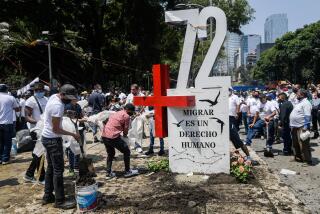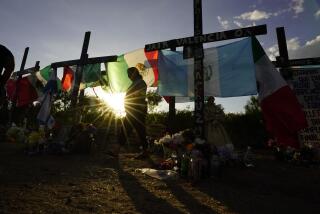Guatemalan families believe victims of massacre in Mexico were their migrant relatives

GUATEMALA CITY — Relatives of migrants from Guatemala said Monday they believed that 13 of the 19 charred corpses found in a northern Mexico border state could be their loved ones. The country’s Foreign Ministry said it was collecting DNA samples from a dozen relatives to see if there was a match with any of the bodies.
If true, the killings would revive memories of the 2010 massacre of 72 migrants in the same gang-ridden state of Tamaulipas.
Ramiro Coronado told the Associated Press by telephone that he had a relative among a group of 13 migrants who had left the province of San Marcos and were traveling together before family members lost contact with them on Thursday.
On Saturday, authorities in Tamaulipas found 19 shot and burned bodies near a town across the Rio Grande from Texas.
Mexican authorities said they were not sure the bodies were those of migrants.
Camargo, the area where the bodies were found, has long been the scene of turf battles between rival drug gangs, and authorities said three rifles were found in the pickup truck where the bodies were piled.
The National Immigration Institute said it was working with foreign consulates in Mexico, but the bodies were so badly burned they could not immediately be identified. Melted remains of what appeared to be cellphones were also found.
Coronado said his nephew, Adán Coronado, 31, had left for the United States along with other migrants in the San Marcos group about two weeks ago.
“They were a group that traveled together,” Coronado said, and they kept in contact with family members back home. But they were apparently in or near Tamaulipas at the time, and since Thursday there had been no word from them.
“It was the first time he had gone” to the U.S., Coronado said. “He said he wanted a better life situation for himself and his family.”
Mario Gálvez, a congressman who represents San Marcos, wrote in his social media accounts that the missing migrants included 10 men and three women.
“We have contacted the relatives, they say that the bodies found are those of their relatives, they have information that it was that group,” Gálvez wrote. “We have asked the Foreign Ministry to help the families with the repatriation of the bodies.
“They cannot find development opportunities in their hometowns, which have historically been totally abandoned by the government,” Gálvez wrote. “The dream of our children and youths has become to reach the United States.”
The Tamaulipas state prosecutor’s office said the bodies were discovered along a dirt road outside Camargo late Friday after residents reported a burning vehicle. Four bodies were found in the cab and near the vehicles, and the other 15 were piled in the bed of the truck.
All had been shot, but shell casings were not found at the site, leading investigators to believe they were killed somewhere else.
A repeat of the 2010 massacre has long been one of the Mexican government’s worst nightmares. In 2019, President Andrés Manuel López Obrador said, “We do not want a repeat of horrendous, regrettable acts like San Fernando.”
In August 2010, Zetas cartel members stopped two tractor-trailers carrying dozens of mostly Central American migrants and took them to a ranch in the Tamaulipas town of San Fernando. After the migrants refused to work for the cartel, they were blindfolded, tied up on the floor and shot dead.
Camargo is a major smuggling transit point for drugs and migrants. Organized-crime groups covet control of stretches of the border because they make money off everything that crosses the border.
Camargo is near the edge of territory historically controlled by factions of the Gulf cartel, and in recent years a remnant of the Zetas known as the Northeast cartel has tried to take over.
In January 2020, 21 bodies, most burned, were found in various vehicles near the neighboring town of Ciudad Mier. Days later, the Mexican army killed 11 alleged gunmen in the area.
More to Read
Sign up for Essential California
The most important California stories and recommendations in your inbox every morning.
You may occasionally receive promotional content from the Los Angeles Times.










